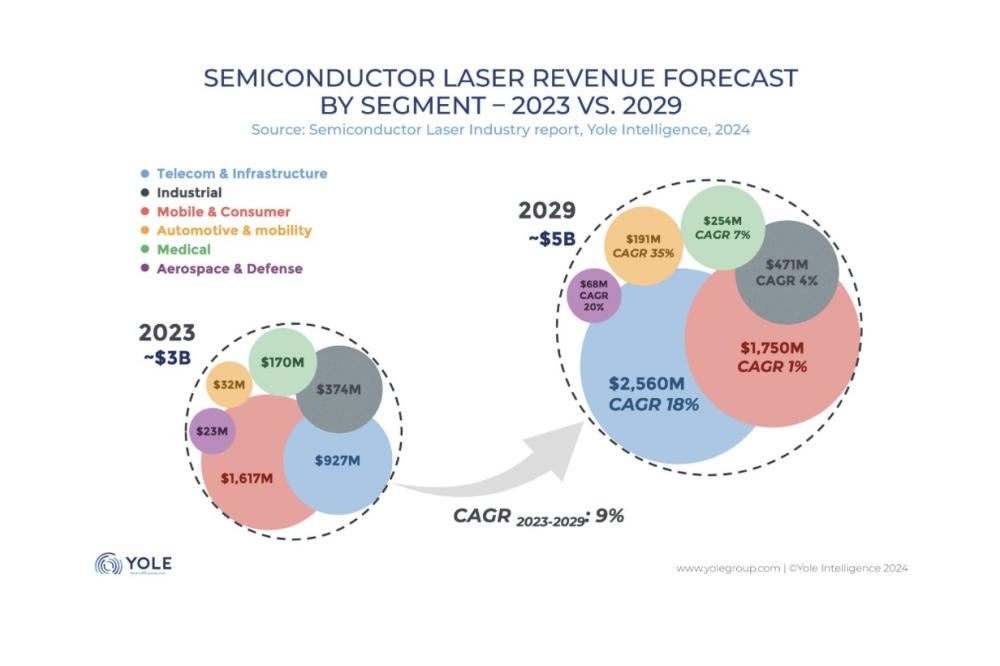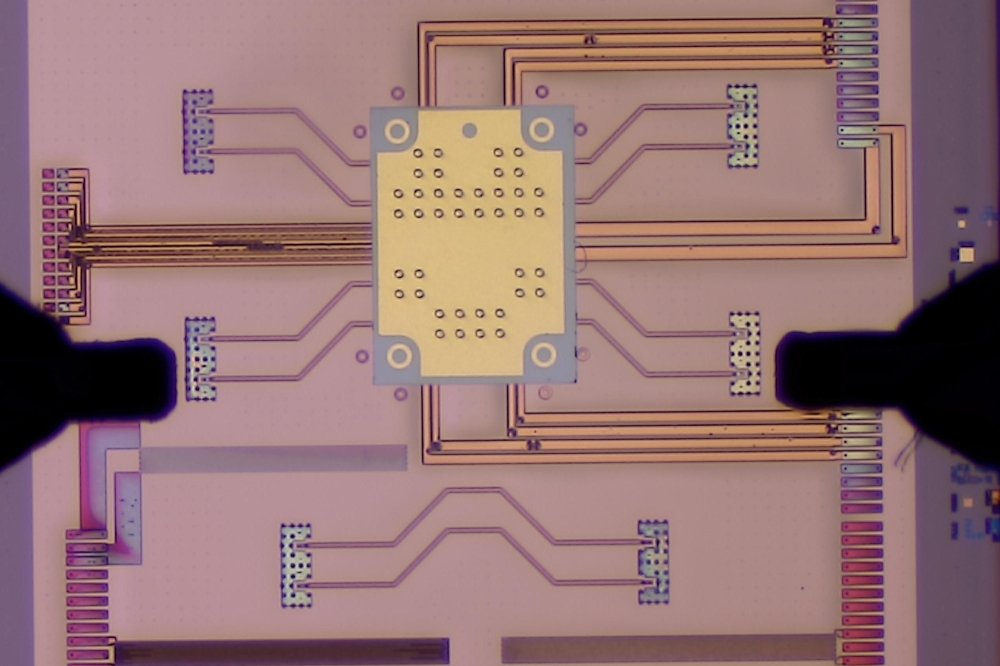GaAs is still the material of choice for many applications
The conference opening session included two invited talks. The first of these was a late change to the program, with Tom Hierl of IQE using the opportunity to present the work done with Motorola on the now much reported GaAs growth on large-area silicon wafers (Compound Semiconductor October 2001, p47). Lester Eastman of Cornell University presented record-breaking data for AlGaN/ GaN HEMTs on SiC substrates. Continuous-wave operation of a 1.5 mm periphery device operating in the 8-10 GHz range gave a power density of 7 W/mm and is expected to reach 10 W/mm with design improvements. HBT developments D Floriot et al. from Thales and UMS discussed the current status of the GaAs HBT as a power technology and the future performance challenges. In particular, improved thermal management was seen as a crucial factor in raising HBT performance levels. The use of a gold layer on emitter fingers has helped to reduce thermal resistance and improve cooling and temperature uniformity across devices. The move towards single and double HBTs operating at 40 GHz is placing a heavy burden on present thermal management techniques. One solution discussed was the use of bump bonding, leading to a 30% improvement in thermal resistance and an enhancement in the reliability of HBTs. This approach introduces a new level of complexity to manufacturing and impacts on yield. Increasing the thickness of the gold layer on emitter fingers introduces problems during back-end processing. A solution to this has been the use of material with high thermal conductivity and diffusive properties to stabilize and limit heating. This approach is based on the use of thick copper or diamond materials on top of the emitter finger to act as a thermal sponge (figure 1). The thin gold layer is retained because it aids bonding of the thermal sponge to the finger. K Stevens et al. from HBT epiwafer vendor Kopin described a promising material technology for enhancing GaAs-based HBT performance. This was based on Kopin s InGaP/ GaAs HBT, but with In and N introduced into the GaAs base layer to lower its energy gap. Device performance improvements, such as lower operating voltages, improved gain stability and higher PAE, can be met by manipulating the relative magnitudes of collector and base current components in GaAs-based HBTs. These current component changes can be made by lowering the base-layer energy gap. Substituting GaInNAs for GaAs in the base layer does this while maintaining a cost-effective GaAs platform. Using this approach over the conventional InGaP/GaAs HBT has lowered operating voltage by 115 mV and given superior temperature stability. This has been achieved while maintaining the standard 500 Å base thickness and 4 x 1019 base doping level. The epitaxial growth is still at an early stage of development and, as this is refined, further HBT performance improvements are expected.
GaAs in space Space-based applications place stringent demands on electronics because of the harsh operating environment and the necessity to keep the mass and volume as low as possible in payloads. Several papers were presented that considered device design and packaging for satellite applications. J Villemazet et al. from Alcatel Space Industries, Toulouse, France, described a new design for a coplanar mixer for integration into a satellite repeater. Compared with the current generation of 12/14 GHz satellite mixers, the Alcatel team s design gave a device about 65% smaller at 1.8 mm2 and provided 2 dB of gain instead of the 10 dB loss that is generally seen in such mixers. The mixer has been successfully integrated into a single MMIC receiver chip. Other functions on the chip include a two-stage IF amplifier, a four-stage local oscillator (LO) differential amplifier and an LO voltage controlled attenuator. The MMIC was fabricated on OMMIC s 0.2 µm PHEMT process, contains 24 PHEMTs and measures 3.7 x 4.2 mm (figure 2).
Equipment used in scientific experiments is another demanding area for electronics. Combine this with space-based radio astronomy, and performance specifications get very tight. The Plank Low Frequency Instrument is a satellite-mounted device to measure variations in the cosmic microwave background radiation. This covers the 30-100 GHz range. B Aja et al. from the University of Cantabria, Santander, Spain, described the development of a Ka-band low-noise amplifier for this application. The noise figure for the amplifier was the critical parameter because the end application was for background noise measurement. The LNA design was fabricated on OMMIC s 0.2 µm depletion-mode PHEMT process with gate widths of 6 x 15 µm. The four-stage design consisted of a low-noise input stage and three gain-flatness stages. The three gain-flatness stages used parallel feedback to reduce gain roll-off with frequency and provide flat gain over a wide bandwidth without impacting on the noise figure. The result was an average noise of 2.3 dB from 28-36 GHz with a gain of more than 20 dB. A minimum noise of 1.2 dB was achieved at 29.5 GHz. Changing the amplifier bias point for increased gain gave 29 dB at 30-31 GHz with an increase in noise to 2.5 dB. Nitrides A number of papers touched on the role of surface passivation in AlGaN/GaN HEMTs. The current slump in the drain when operating at high drain bias is caused by the trapping of electrons by empty surface states. The build-up of charge depletes the channel and limits the available RF current amplitude. Surface passivation using SiN has been found to alleviate this problem.
H Leier et al. from DaimlerChrysler, EADS and QinetiQ compared the RF performance of passivated and non-passivated AlGaN/GaN HFETs grown on SiC and sapphire. Though passivation made no significant difference to carrier concentration and mobility, RF performance was markedly improved. RF power measurements were made on devices grown on sapphire with 2 x 100 µm gates and operated with a Vds of 25 V. At 2.5 GHz the unpassivated device gave a saturated output power density of 1.7 W/mm and PAE of 41%. Surface passivation improved these figures to 3.1 W/mm and 55%. Similar improvements were observed for devices on SiC with RF power rising from 24.8 to 29.1 dBm when passivated and PAE improving from 35% to 59% (figure 3). While the best AlGaN/GaN HEMTs have so far been grown on SiC substrates, these are prohibitively expensive compared with silicon or sapphire and are not available as large-diameter wafers. The SIGANTIC process developed by Nitronex allows the growth of thick, high-quality GaN and AlGaN layers on cheap, large area silicon substrates. W Sutton et al. from the University of Michigan and Nitronex reported the first fabrication of AlGaN/GaN HEMTs with 1 µm gate lengths on SIGANTIC substrates. A 2 x 75 µm periphery HEMT gave a maximum current density of 0.4 A/mm and a maximum breakdown voltage, BVds, of 35 V. Curiously, maximum values for transconductance for all of the devices occurred at positive gate bias as opposed to the negative bias values usually reported for GaN HEMTs. An fmax of 12 GHz was obtained at a Vds of 15 V and the maximum ft value observed was 5.8 GHz. Significant improvements are expected on these figures as ohmic contacts are improved and gate lengths drop below 1 µm.































